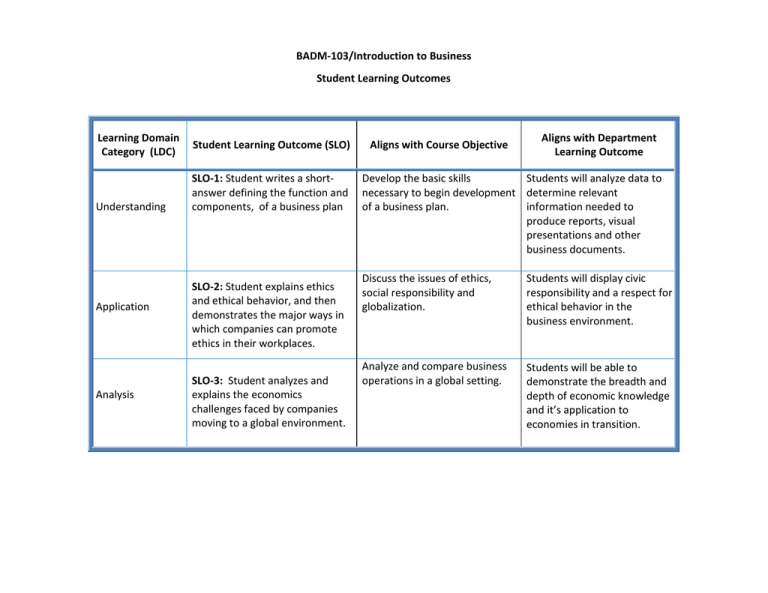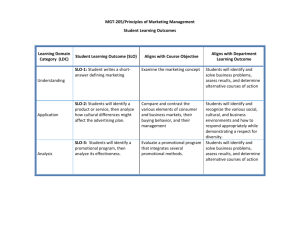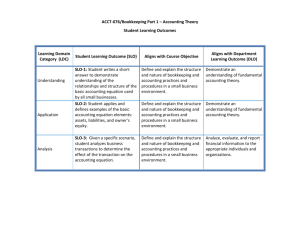BADM103 SLOs and Rubric
advertisement

BADM-103/Introduction to Business Student Learning Outcomes Learning Domain Category (LDC) Understanding Application Analysis Student Learning Outcome (SLO) SLO-1: Student writes a shortanswer defining the function and components, of a business plan SLO-2: Student explains ethics and ethical behavior, and then demonstrates the major ways in which companies can promote ethics in their workplaces. SLO-3: Student analyzes and explains the economics challenges faced by companies moving to a global environment. Aligns with Course Objective Aligns with Department Learning Outcome Develop the basic skills Students will analyze data to necessary to begin development determine relevant of a business plan. information needed to produce reports, visual presentations and other business documents. Discuss the issues of ethics, social responsibility and globalization. Students will display civic responsibility and a respect for ethical behavior in the business environment. Analyze and compare business operations in a global setting. Students will be able to demonstrate the breadth and depth of economic knowledge and it’s application to economies in transition. Assessment Rubric forBADM-103/Introduction to Business This Rubric will be used to assess student learning outcomes based on learning domain categories using varying levels. Learning Domain Category (LDC) Knowledge Does Not Meet: 0 Approaches: 1-2 Meets: 3-4 Exceeds: 5 No evidence for knowledge No evidence for understand ing No evidence for application Recalls some business content and definitions but not always accurately Identifies most business definitions, principles, methodologies and theories accurately Explains/demonstrates business ideas, concepts and principles with some accuracy and relevant examples Applies business knowledge and concepts with some degree of consistently and accuracy Identifies significant business definitions, principles, methodologies and theories accurately Explains/demonstrates business ideas, concepts and principles accurately and relevant examples Analysis No evidence for analysis Breaks down theories, strategies, and methods into their elements with difficulty Breaks down theories, strategies, and methods into their elements with minimal difficulty Breaks down theories strategies, and methods into their elements with accuracy Synthesis No evidence for synthesis No evidence for evaluation Integrates relevant knowledge from diverse business perspectives with little depth and breadth Determines with a minimal degree of effectiveness business theories, policies, or choices in problem solving Integrates relevant knowledge from diverse business perspectives with some depth and breadth Determines with some degree of effectiveness business theories, policies, or choices in problem solving Integrates relevant knowledge from diverse business perspectives with depth and breadth Demonstrates ability to assess the effectiveness of business theories, policies, or choices in problem solving Understand Application Evaluation Student not present (N/A) Explains/demonstrates business ideas, concepts and principles with limited accuracy and irrelevant examples Applies business knowledge and concepts with little consistency or accuracy Applies business knowledge and reasoning with consistently and accuracy Score: 0-5



